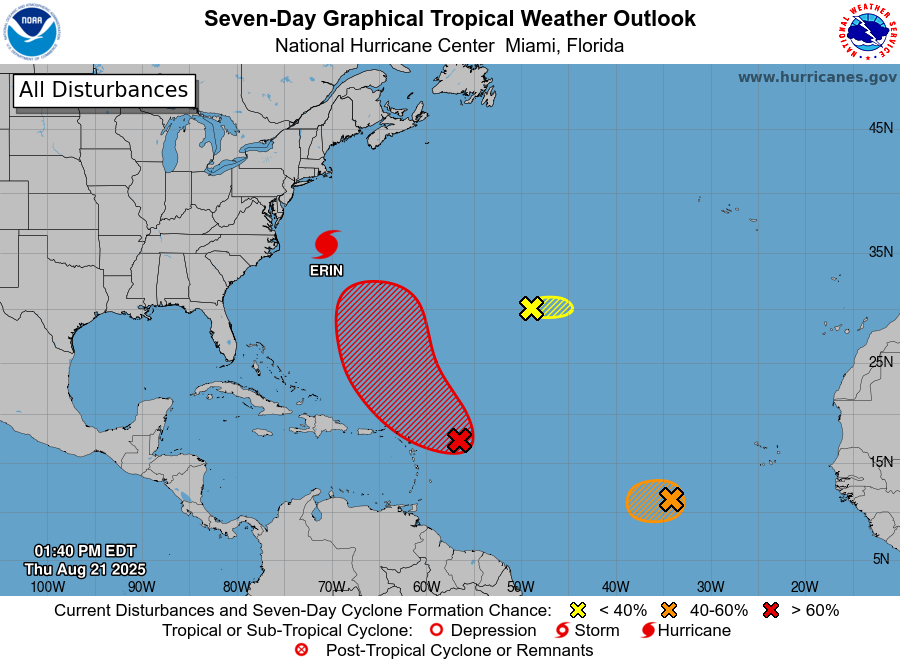
Erin Remains a Vast Category Two Hurricane
Hurricane Erin remains a vast Category Two Hurricane as it moves up the Eastern Seaboard on this Thursday afternoon. Maximum sustained winds have decreased to 100 miles per hour while its minimum central pressure has dropped to 952 millibars or 28.12 inches of Hg. Meanwhile, three other disturbances are also being watched in the Atlantic with Invests 90L and 99L having the best chance to develop. Finally, the Eastern Pacific shows signs of becoming active again. Let’s take a look around in this latest edition of Tracking the Tropics.
Hurricane Erin
The key story now with Erin is its massive size. With a diameter of over 800 miles, tropical storm force winds extending 500 miles across, and cloud cover extending some 1,000 miles across, Erin is stirring up the waters from Florida to Maine.
A high rip current risk remains in effect for the East Coast of the United States from north of Miami, Florida to the southern border of Maine in New England. Storm surge levels range anywhere from 1 to 3 feet in the Mid-Atlantic to 2 to 4 feet along the Outer Banks of North Carolina.
As of the 11:00 AM EDT advisory from the National Hurricane Center, Erin is still a formidable storm at Category Two strength on the Saffir-Simpson Scale. Maximum sustained winds have slackened to 100 miles per hour while its minimum central pressure has risen to 952 millibars, or 28.12 inches. Erin is moving more rapidly to the north-northeast at 18 miles per hour. Erin’s diameter has swelled to 1,000 miles including its cloud canopy.
Hurricane-force winds now reach out some 105 miles from the eye while tropical-storm-force winds extend another 320 miles from the center. Looking at the latest vortex message, the eye of Erin is now negligible. Tropical Storm Warnings are in effect from Beaufort Inlet, North Carolina to Chincoteauge, Virginia, on the southern tip of the Delmarva Peninsula.
A Tropical Storm Watch remains in effect for Bermuda, but the vast size of the storm is bringing tropical storm conditions to the island. This development will likely force the government of Bermuda to upgrade the watch to a warning at some point during the day on Thursday. A Storm Surge Warning is in effect from Cape Lookout to Duck, North Carolina. Wave heights at Nag’s Head, North Carolina are between 12 and 14 feet.
Erin Producing Dangerous Surf Up and Down the Mid-Atlantic Coast
On Tuesday evening, Greg’s Weather Center and Hurricaneville traveled down to Manasquan, New Jersey to check out the surf conditions there. Only surfers dared to take on the building waves from the pressure gradient produced by the combination of strong high pressure to the north and Hurricane Erin to the south.
Wave heights at that point were likely around 6 feet. People on the beach stood in awe at the power of Mother Nature. Yesterday, those wave heights continued to grow. Many beaches along the Jersey Shore as well as beaches in Delaware and as far south as Ocean City, Maryland were closed to swimming.
The wave heights along the Mid-Atlantic from the southern end of the Delmarva Peninsula in Virginia to Long Island. The National Weather Service office in Mount Holly, NJ has issued a High Surf Advisory in effect until 8:00 PM on Friday for the Delaware Beaches and Atlantic and Coastal Cape May, Coastal Ocean, and Eastern Monmouth counties.
In addition, there is also a Coastal Flood Warning in effect for these areas until early Saturday morning at 2:00 AM. This portion of the Mid-Atlantic coast is expected to see large breaking waves as high as 7 to 12 feet on Thursday, and 6 to 9 feet on Friday. A High Rip Current Risk remains in effect as well.
With such a powerful and massive storm stirring up the ocean, it will take some time for the dangerous surf and rip currents to wind down. So, if you are planning to go down the shore this weekend, please monitor the latest weather reports and check with local authorities. Otherwise, stay out of the water.
Four Disturbances in the Atlantic
There are now four tropical features in the Atlantic that are being monitored by the National Hurricane Center on this Thursday afternoon. There is now a disturbance in the Central Atlantic that is located some 1,200 miles to the southwest of the Azores.

This small area of low pressure is producing very little in convection and is in a location where conditions are marginally favorable for development. Meanwhile, the disturbance near the Leeward Islands has been designated Invest 90L and has a 50 percent chance of formation over the next 48 hours and a 70 percent chance over the next 7 days.
Finally, there is still Invest 99L, which continues to head westward in the Eastern Atlantic. The disturbance still has a medium or 40 percent chance of development over the next 48 hours to a week. The Atlantic remains the busiest of the basins in the Western Hemisphere, but the Eastern Pacific is showing signs of becoming active again.
Eastern Pacific Beginning to Wake Up Again
While the Central Pacific remains tranquil, the Eastern Pacific is showing signs of waking up again. According to the NHC, an area of low pressure is likely to form this coming weekend off the coast of Southwestern Mexico. The disturbance has a medium chance of about 40 percent of developing over the next 7 days.
